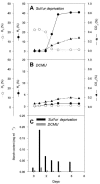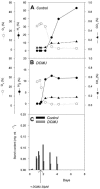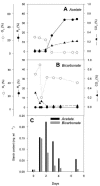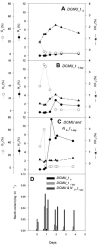Autotrophic and mixotrophic hydrogen photoproduction in sulfur-deprived chlamydomonas cells
- PMID: 16204539
- PMCID: PMC1265920
- DOI: 10.1128/AEM.71.10.6199-6205.2005
Autotrophic and mixotrophic hydrogen photoproduction in sulfur-deprived chlamydomonas cells
Abstract
In Chlamydomonas reinhardtii cells, H2 photoproduction can be induced in conditions of sulfur deprivation in the presence of acetate. The decrease in photosystem II (PSII) activity induced by sulfur deprivation leads to anoxia, respiration becoming higher than photosynthesis, thereby allowing H2 production. Two different electron transfer pathways, one PSII dependent and the other PSII independent, have been proposed to account for H2 photoproduction. In this study, we investigated the contribution of both pathways as well as the acetate requirement for H2 production in conditions of sulfur deficiency. By using 3-(3,4-dichlorophenyl)-1,1-dimethylurea (DCMU), a PSII inhibitor, which was added at different times after the beginning of sulfur deprivation, we show that PSII-independent H2 photoproduction depends on previously accumulated starch resulting from previous photosynthetic activity. Starch accumulation was observed in response to sulfur deprivation in mixotrophic conditions (presence of acetate) but also in photoautotrophic conditions. However, no H2 production was measured in photoautotrophy if PSII was not inhibited by DCMU, due to the fact that anoxia was not reached. When DCMU was added at optimal starch accumulation, significant H2 production was measured. H2 production was enhanced in autotrophic conditions by removing O2 using N2 bubbling, thereby showing that substantial H2 production can be achieved in the absence of acetate by using the PSII-independent pathway. Based on these data, we discuss the possibilities of designing autotrophic protocols for algal H2 photoproduction.
Figures




References
-
- Antal, T. K., T. E. Kredeleva, T. V. Laurinavichene, V. V. Makarova, M. L. Ghirardi, A. B. Rubin, A. Tsygankov, and M. Seibert. 2003. The dependence of algal H2 production on photosystem II and O2 consumption activities in sulfur-deprived Chlamydomonas reinhardtii cells. Biochim. Biophys. Acta 1607:153-160. - PubMed
-
- Chen, F., and M. R. Johns. 1996. Heterotrophic growth of Chlamydomonas reinhardtii on acetate in chemostat culture. Process Biochem. 31:601-604.
-
- Chen, F., and M. R. Johns. 1994. Substrate inhibition of Chlamydomonas reinhardtii by acetate in heterotrophic culture. Process Biochem. 29:245-252.
-
- Cournac, L., F. Mus, L. Bernard, G. Guedeney, P. Vignais, and G. Peltier. 2002. Limiting steps of hydrogen production in Chlamydomonas reinhardtii and Synechocystis PCC 6803 as analysed by light-induced gas exchange transients. Int. J. Hydrogen Energy 27:1229-1237.
Publication types
MeSH terms
Substances
LinkOut - more resources
Full Text Sources
Other Literature Sources

